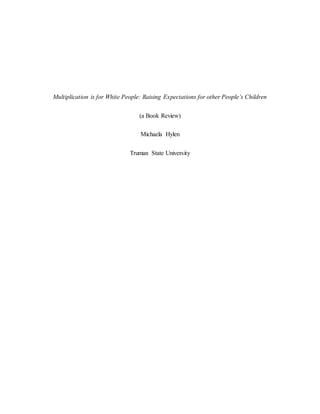
Multiplication is for White People
- 1. Multiplication is for White People: Raising Expectations for other People’s Children (a Book Review) Michaela Hylen Truman State University
- 2. Multiplication is for White People: Raising Expectations for Other People’s Children 1 Lisa Delpit, educator and author of “Multiplication is for White People”: Raising Expectations for Other People’s Children, has created such a stunning and inspiring work in 2012 book about educating culturally diverse students. Throughout this book Delpit explores the how’s and why’s of the education gap among students of different ethnicities as well as what educators can do to lessen the gap and promote a healthy learning environment for all students. This book depicts life as a student from a lens that many white educators, and most certainly I, have never considered. From elementary school to a university setting, “Multiplication is for White People”: Raising Expectations for Other People’s Children does a wonderful job of giving perspective to up and coming educators of diverse students. The beginning chapters of this book start by explaining how “there is no achievement gap at birth,” and how all students have an infinite capacity to learn and achieve. Delpit points to a study of infants and toddlers from white, middle-class homes compared with infants and toddlers from black families and even families in Africa. The study found that while children from the white families were quicker to pick up speech and language the black children were quicker and better able to learn what many consider street smarts. The black children would crawl and walk earlier, and have a better sense of how to take care of younger siblings and other children. Later on in the chapter Delpit discusses how elementary schools are prone to judge a child’s intellectual capabilities based on language and acquired language skills. Because white children are able to pick up on more language at home than many black children the schools find the black children to be behind in their learning or not as smart, despite the fact that the black children have a very comprehensive understanding of many other skills and are just as capable to learn.
- 3. Multiplication is for White People: Raising Expectations for Other People’s Children 2 In part two, Lisa Delpit discusses the idea of warm demanders, teachers who have high expectations for their students and demand results but do so in an encouraging way. Teachers who are warm demanders look at all students as having the ability to achieve and prompt them to achievement. Students, especially black students, respond well to warm demanding teachers, and often these students report higher achievement and higher satisfaction in classes with these teachers. Delpit interviewed a group of students and asked them to describe a good teacher they had encountered, and the attributes of a good teacher were often warm demanders and teachers who take time to get to know their students. Another major point in the book was how and what we teach children of color. Since many of today’s lesson plans are white centered children of color have a hard time identifying and feeling included. This isolation turns them off to the idea of school. In a school entirely comprised of black students the curriculum includes examining African culture and heritage as well as important topics in the civil rights movement and so forth. These students are high performing and are genuinely interesting in going to school. By teaching students to their culture schools set up students to succeed. The remainder of the book is entirely focused on educating older students, discussing demanding critical thinking, framing assessment, and inspiring a drive for excellence. Part four is narrowed in on post-secondary education of students of color. Delpit tells of her own experience in universities as a student and an educator, and how she learned to succeed in an environment not always accepting of her. The concept of disidentification is examined, the how and why it happens and possible ways to stop it. Overall Lisa Delpit encourages educators to design campuses that do not isolate students of different ethnicities and do not treat these students as if they are endangered.
- 4. Multiplication is for White People: Raising Expectations for Other People’s Children 3 “Multiplication is for White People”: Raising Expectations for Other People’s Children opened my eyes to a very different side of education that I had not considered before. I found that Lisa Delpit did an incredible job presenting the issues and possible solutions in a way that someone such as I who is in the white majority of the population did not feel isolated. There were several topics discussed in this book that I thoroughly enjoyed reading about, most specifically the idea of warm demanders. My only qualm with this work is that I would’ve liked if it was written to include students of other minority ethnicities as well, but I understand the need to focalize and limit the concepts in the book to one specific group. In general I truly appreciated Lisa Delpit’s writing and the topics of the book, I will most likely reread this book and encourage any future educators to read it as well. The field could be greatly improved with some of the ideas given in “Multiplication is for White People”: Raising Expectations for Other People’s Children. Many inner-city schools are comprised of high populations of minority students, so educators in these schools need to learn how to best identify with these students. Delpit’s solutions for some of the American education system’s problems are in the least compelling arguments for how to close the achievement gap between ethnicities. Statistics and true stories from this book give examples of how these concepts have worked and how they could work in other schools. With an increasingly diverse group of students in each teacher’s classroom, the system needs to address new possibilities and new solutions to old problems involving diversity, and this book may be a good place to start.